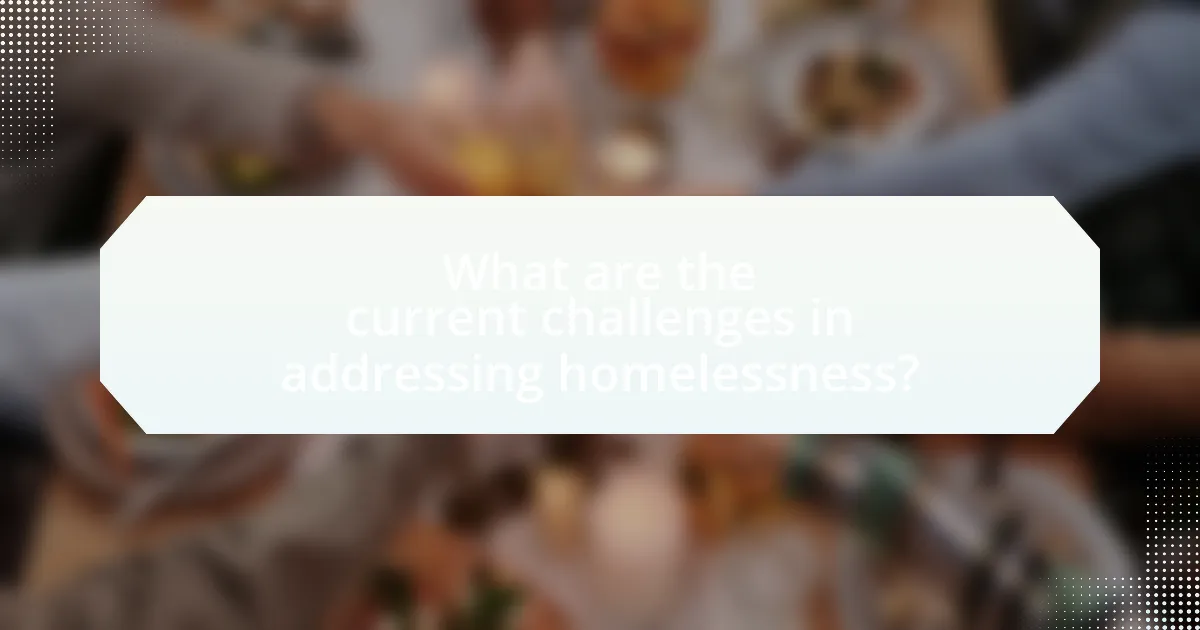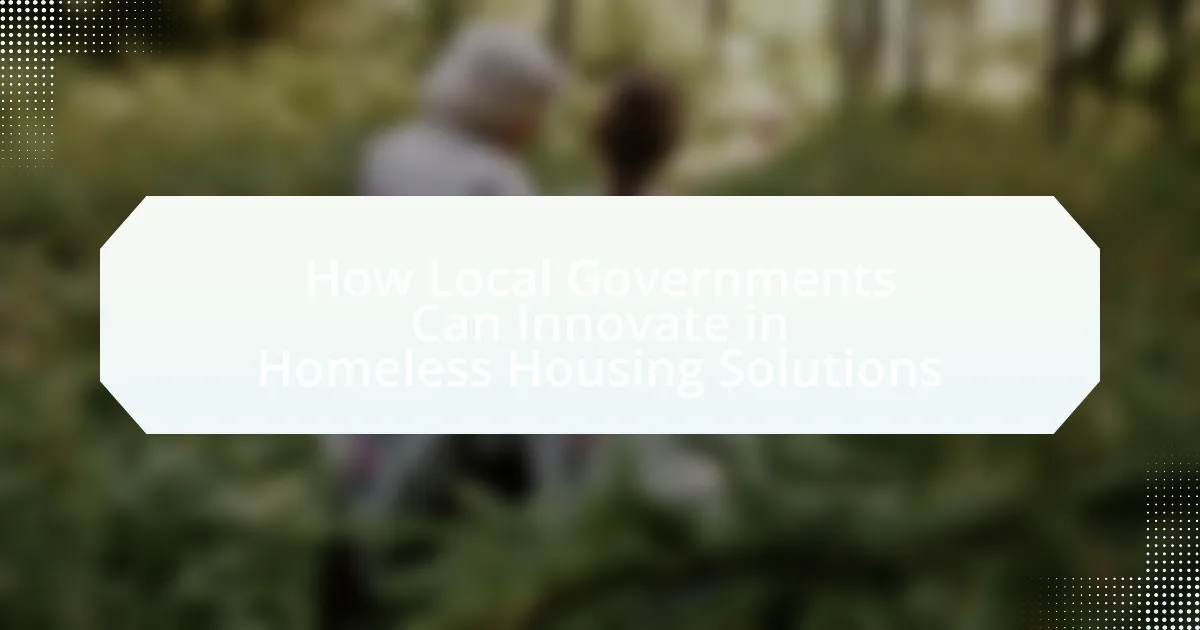The article focuses on how local governments can innovate in homeless housing solutions to effectively address the ongoing challenges of homelessness. It outlines current obstacles such as the lack of affordable housing, insufficient funding for support services, and systemic barriers. The article discusses various responses from local governments, including emergency services and supportive housing initiatives, while highlighting traditional housing solutions like permanent supportive housing and transitional housing. It emphasizes the need for innovative strategies, such as modular housing and technology integration, to improve the quality of life for homeless individuals and enhance resource allocation. Additionally, the article underscores the importance of community involvement and collaboration with stakeholders to create sustainable and effective housing solutions.

What are the current challenges in addressing homelessness?
Current challenges in addressing homelessness include a lack of affordable housing, insufficient funding for support services, and systemic barriers such as discrimination and mental health issues. The National Alliance to End Homelessness reports that the shortage of affordable rental units has reached over 7 million, making it difficult for low-income individuals to secure stable housing. Additionally, funding for essential services like mental health care and substance abuse treatment remains inadequate, limiting the effectiveness of interventions. Systemic issues, including discrimination against marginalized groups and the stigma surrounding homelessness, further complicate efforts to provide effective solutions.
How do local governments currently respond to homelessness?
Local governments currently respond to homelessness through a combination of emergency services, supportive housing initiatives, and policy reforms. Many municipalities implement emergency shelters and transitional housing programs to provide immediate relief for individuals experiencing homelessness. For instance, cities like Los Angeles have expanded their shelter capacity and created temporary housing solutions to address urgent needs. Additionally, local governments often collaborate with non-profit organizations to offer wraparound services, including mental health support and job training, which are essential for long-term stability. According to the U.S. Department of Housing and Urban Development, communities that invest in supportive housing have seen a significant reduction in chronic homelessness, demonstrating the effectiveness of these approaches.
What traditional housing solutions are being utilized?
Traditional housing solutions being utilized include permanent supportive housing, transitional housing, and emergency shelters. Permanent supportive housing combines affordable housing with supportive services, effectively addressing chronic homelessness; studies show that this model reduces homelessness by 80% in some areas. Transitional housing provides temporary accommodation with supportive services aimed at helping individuals move to permanent housing, which has been shown to improve housing stability. Emergency shelters offer immediate, short-term relief for those in crisis, serving as a critical first step in the housing continuum. These solutions are foundational in local government strategies to combat homelessness effectively.
What are the limitations of these traditional approaches?
Traditional approaches to homeless housing solutions often face significant limitations, including inadequate funding, lack of comprehensive support services, and inflexible policies. Inadequate funding restricts the ability of local governments to develop and maintain sufficient housing units, leading to overcrowding and insufficient resources for those in need. The lack of comprehensive support services, such as mental health care and job training, hinders the long-term success of housing initiatives, as individuals may struggle to maintain stable housing without additional assistance. Furthermore, inflexible policies can prevent local governments from adapting to the unique needs of their communities, resulting in one-size-fits-all solutions that fail to address the diverse challenges faced by the homeless population. These limitations highlight the need for innovative strategies that can better meet the needs of homeless individuals and families.
Why is innovation necessary in homeless housing solutions?
Innovation is necessary in homeless housing solutions to effectively address the complex and evolving needs of the homeless population. Traditional housing methods often fail to provide sustainable and adaptable solutions, leading to persistent homelessness. Innovative approaches, such as modular housing and supportive services integration, have been shown to reduce costs and improve outcomes. For instance, a study by the National Alliance to End Homelessness found that permanent supportive housing reduces homelessness by 80% and is cost-effective compared to emergency services. Therefore, innovation is crucial for creating efficient, scalable, and humane housing solutions that can significantly impact homelessness.
How can innovative solutions improve the quality of life for the homeless?
Innovative solutions can significantly improve the quality of life for the homeless by providing access to affordable housing, essential services, and supportive resources. For instance, initiatives like tiny home villages and modular housing have been shown to reduce homelessness by offering stable living conditions, which in turn leads to better health outcomes and increased employment opportunities. A study by the National Alliance to End Homelessness found that permanent supportive housing reduces homelessness by 80% and improves mental health and well-being among residents. Additionally, technology-driven solutions, such as mobile apps that connect homeless individuals with available resources and services, enhance their ability to access food, healthcare, and job training, further elevating their quality of life.
What role does community involvement play in innovation?
Community involvement is crucial in driving innovation, particularly in addressing complex issues like homelessness. Engaging local residents and stakeholders fosters diverse perspectives, which can lead to more effective and tailored housing solutions. For instance, a study by the Urban Institute found that community-driven initiatives often result in higher satisfaction rates and better outcomes in housing projects, as they reflect the actual needs and preferences of the population. This collaborative approach not only enhances creativity but also builds trust and accountability, essential for sustainable innovation in local government initiatives.

What innovative strategies can local governments implement?
Local governments can implement innovative strategies such as creating public-private partnerships to develop affordable housing solutions. These partnerships leverage resources and expertise from both sectors, enabling the construction of low-cost housing units. For instance, cities like Los Angeles have successfully collaborated with private developers to create supportive housing projects, resulting in a significant increase in available units for homeless individuals. Additionally, local governments can adopt modular housing techniques, which reduce construction time and costs, as demonstrated by initiatives in cities like Seattle, where modular units have been rapidly deployed to address homelessness.
How can modular housing contribute to solving homelessness?
Modular housing can significantly contribute to solving homelessness by providing affordable, quickly constructed living spaces. These units can be built in a fraction of the time compared to traditional housing, often within a few months, which allows for rapid deployment in response to urgent housing needs. For instance, cities like Los Angeles have implemented modular housing projects that have successfully housed hundreds of individuals experiencing homelessness, demonstrating a practical solution to a pressing social issue. Additionally, modular homes can be produced at lower costs, with estimates suggesting savings of up to 20% compared to conventional building methods, making them a financially viable option for local governments aiming to address homelessness effectively.
What are the benefits of modular housing over traditional methods?
Modular housing offers several benefits over traditional construction methods, including reduced construction time, cost efficiency, and improved sustainability. Modular homes can be built in a factory setting, allowing for faster assembly on-site, which can cut construction time by up to 50% compared to traditional building methods. This speed not only accelerates the availability of housing but also reduces labor costs. Additionally, modular construction often results in less waste, as materials are used more efficiently in a controlled environment, contributing to a lower environmental impact. According to a study by the National Institute of Standards and Technology, modular construction can reduce energy consumption during the building process by up to 20%. These advantages make modular housing a compelling option for local governments seeking innovative solutions to address homelessness.
How can local governments facilitate the development of modular housing?
Local governments can facilitate the development of modular housing by streamlining zoning regulations and providing financial incentives. By simplifying the approval process for modular housing projects, local governments can reduce bureaucratic delays that often hinder development. For instance, cities like San Jose, California, have implemented expedited permitting processes specifically for modular units, which can significantly decrease construction timelines. Additionally, offering tax breaks or grants to developers who focus on modular housing can encourage investment in this sector. Research from the National Association of Home Builders indicates that modular construction can reduce building costs by 10-20%, making it a financially viable option for addressing housing shortages.
What role does technology play in innovative housing solutions?
Technology plays a crucial role in innovative housing solutions by enabling efficient design, construction, and management of housing projects. Advanced technologies such as 3D printing, modular construction, and smart home systems streamline the building process, reduce costs, and enhance sustainability. For instance, 3D printing can significantly decrease construction time and material waste, with projects like ICON’s 3D-printed homes demonstrating the potential to create affordable housing rapidly. Additionally, smart home technologies improve energy efficiency and provide better living conditions, which are essential for addressing homelessness effectively. These innovations not only facilitate the creation of housing but also ensure that the solutions are adaptable and scalable to meet the needs of diverse populations.
How can data analytics improve resource allocation for homeless services?
Data analytics can improve resource allocation for homeless services by enabling local governments to identify trends, needs, and gaps in service delivery. By analyzing data from various sources, such as shelter occupancy rates, demographic information, and service utilization patterns, governments can make informed decisions about where to allocate resources most effectively. For instance, a study by the Urban Institute found that cities using data analytics to track homelessness trends were able to reduce homelessness by 20% over five years by targeting resources to areas with the highest need. This targeted approach ensures that funding and services are directed to the most vulnerable populations, ultimately enhancing the efficiency and effectiveness of homeless services.
What technological tools can enhance communication with the homeless population?
Mobile applications, SMS services, and social media platforms can enhance communication with the homeless population. Mobile applications like “Homeless Outreach” provide real-time information on available resources, shelters, and services tailored for the homeless. SMS services enable quick dissemination of critical information, such as emergency shelter availability or health services, directly to individuals without requiring internet access. Social media platforms facilitate community engagement and awareness, allowing local governments and organizations to share updates and connect with the homeless population effectively. According to a study by the National Alliance to End Homelessness, technology can bridge gaps in communication, leading to improved access to services and resources for homeless individuals.

How can local governments collaborate with other stakeholders?
Local governments can collaborate with other stakeholders by forming partnerships with non-profit organizations, private sector entities, and community groups to address homelessness effectively. These collaborations can involve sharing resources, expertise, and data to create comprehensive housing solutions. For instance, the U.S. Interagency Council on Homelessness emphasizes the importance of coordinated efforts among local governments and stakeholders to implement best practices and leverage funding opportunities, which can enhance the effectiveness of housing initiatives.
What partnerships are essential for effective homeless housing solutions?
Effective homeless housing solutions require partnerships between local governments, non-profit organizations, and private sector stakeholders. Local governments provide funding and policy support, while non-profits offer expertise in service delivery and community engagement. The private sector contributes resources and innovative approaches to housing development. For instance, a study by the National Alliance to End Homelessness highlights that collaborative efforts among these entities can lead to more sustainable housing solutions, demonstrating that integrated approaches significantly reduce homelessness rates.
How can non-profit organizations support local government initiatives?
Non-profit organizations can support local government initiatives by collaborating on programs that address homelessness, providing resources, and facilitating community engagement. For instance, non-profits can offer expertise in developing housing solutions, such as transitional housing or permanent supportive housing, which aligns with local government goals to reduce homelessness. A study by the National Alliance to End Homelessness highlights that partnerships between non-profits and local governments can lead to more effective use of funding and resources, ultimately improving outcomes for homeless individuals. Additionally, non-profits can mobilize volunteers and community members to participate in initiatives, enhancing public awareness and support for local government efforts.
What role do private sector investments play in innovative housing solutions?
Private sector investments are crucial in driving innovative housing solutions by providing necessary capital, expertise, and efficiency. These investments enable the development of affordable housing projects, leveraging private funding to complement public resources. For instance, in 2020, private sector contributions accounted for approximately 70% of funding in affordable housing initiatives in the United States, demonstrating their significant impact. Additionally, private companies often introduce advanced construction technologies and sustainable practices, which enhance the quality and reduce the costs of housing solutions. This collaboration between the private sector and local governments fosters a more dynamic approach to addressing homelessness and housing shortages.
How can local governments measure the success of their innovative strategies?
Local governments can measure the success of their innovative strategies by utilizing specific performance metrics such as reduction in homelessness rates, cost-effectiveness of housing solutions, and stakeholder satisfaction. For instance, tracking the number of individuals transitioned from homelessness to stable housing provides a clear indicator of effectiveness. Additionally, analyzing the financial savings generated from reduced emergency services usage can demonstrate cost-effectiveness. Surveys and feedback from residents and service providers can further gauge satisfaction and community impact, reinforcing the overall assessment of innovative strategies.
What metrics should be used to evaluate the effectiveness of housing solutions?
To evaluate the effectiveness of housing solutions, key metrics include housing stability, cost-effectiveness, and resident satisfaction. Housing stability measures the duration residents remain in housing without returning to homelessness, indicating the solution’s long-term success. Cost-effectiveness assesses the financial efficiency of the housing solution by comparing the costs incurred to the benefits gained, such as reduced emergency service usage. Resident satisfaction gauges the quality of life and well-being of individuals in housing, reflecting the solution’s impact on their daily lives. These metrics collectively provide a comprehensive assessment of housing solutions’ effectiveness in addressing homelessness.
How can feedback from the homeless community inform future strategies?
Feedback from the homeless community can inform future strategies by providing direct insights into their needs, preferences, and experiences with existing services. Engaging with this population allows local governments to identify gaps in current housing solutions and tailor interventions that are more effective. For instance, studies have shown that when homeless individuals are involved in the planning process, programs are more likely to succeed; a report by the National Alliance to End Homelessness highlights that participatory approaches lead to better outcomes in housing stability. By incorporating feedback, local governments can create more responsive and sustainable housing solutions that address the unique challenges faced by the homeless community.
What best practices can local governments adopt for sustainable innovation?
Local governments can adopt best practices for sustainable innovation by implementing collaborative partnerships, utilizing data-driven decision-making, and promoting community engagement. Collaborative partnerships with non-profits, private sectors, and academic institutions can leverage resources and expertise, enhancing the effectiveness of housing solutions. Data-driven decision-making allows local governments to analyze trends and needs, ensuring that policies are responsive and effective; for instance, cities like San Francisco have used data analytics to optimize resource allocation for homeless services. Promoting community engagement fosters trust and ensures that solutions are tailored to the specific needs of the population, as seen in participatory budgeting initiatives in cities like Paris, which empower residents to influence funding decisions.
How can continuous improvement be integrated into housing programs?
Continuous improvement can be integrated into housing programs by implementing regular feedback mechanisms and data-driven assessments to enhance service delivery and program effectiveness. Local governments can establish processes for collecting input from residents, stakeholders, and service providers, which allows for the identification of areas needing improvement. For instance, the use of performance metrics, such as occupancy rates and resident satisfaction surveys, can provide quantifiable data that informs necessary adjustments. Research indicates that programs employing continuous improvement methodologies, like Plan-Do-Study-Act cycles, have shown increased efficiency and better outcomes in housing initiatives, as evidenced by the success of the Housing First model in various cities, which emphasizes iterative learning and adaptation based on real-world results.
What lessons can be learned from successful case studies in other regions?
Successful case studies in other regions demonstrate that collaboration between local governments, non-profits, and community stakeholders is essential for effective homeless housing solutions. For instance, the “Housing First” model implemented in Finland has significantly reduced homelessness by providing permanent housing without preconditions, leading to a 43% decrease in homelessness from 2008 to 2019. Additionally, the integration of supportive services, as seen in the successful initiatives in Utah, highlights the importance of addressing underlying issues such as mental health and substance abuse, resulting in a 91% reduction in chronic homelessness. These examples underscore the necessity of tailored approaches that consider local contexts and the involvement of diverse partners to create sustainable solutions.

Leave a Reply